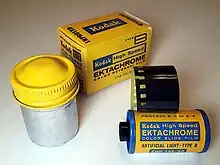E-3 process
The E-2 process and E-3 process are outdated processes for developing Ektachrome reversal photographic film. The two processes are very similar, and differ depending on the film. Kodak sold kits that could process either kind of film.
- See also Ektachrome for full details of Kodak E-series processes.

Processing


Ektachrome film has three separate light-sensitive layers; each layer is sensitive to a different group of wavelengths corresponding to red, green, and blue colors. When the film is exposed, each layer records a latent image based on its sensitivity. A yellow filter prevents blue light from exposing the green- and red-sensitive layers, which have some sensitivity to blue light.[1]
Films are processed at 75 °F (23.9 °C) with a tolerance of only ±0.5°F; exceeding these limits could cause color shifts.[2]: 30–31 The steps are:
| Step | Schematic | E-1 (1946)[3] | E-1 (1955)[2]: 30–31 E-2 (1955)[3] E-3 (1959)[3] | Description | ||||
|---|---|---|---|---|---|---|---|---|
| Time (min) | Temp. | Time (min) | Temp. | |||||
| 1 | First developer |  |
15 | 68 °F (20 °C) | 10 | 75 °F (24 °C) | This is a conventional black-and-white developer, which develops the exposed portions as a negative. | |
| 2 | Stop bath / rinse | 1 | 65–72 °F (18–22 °C) | 1 | 73–77 °F (23–25 °C) | |||
| 3 | Hardener | 5–10 | 66–70 °F (19–21 °C) | 3–10 | 73–77 °F (23–25 °C) | |||
| 4 | Reversal exposure |  |
varies (typically 5 sec/side) | The film is removed from the tank and thoroughly exposed with a bright light for either 5 seconds on each side, or each end of the reel is exposed for 15 seconds at a distance of 1 ft (0.30 m) from a No. 2 photoflood. This step sensitizes the remaining silver halide crystals for the colour developer. Replace in tank, though the lid was no longer required. | ||||
| 5 | Wash | 5 | 65–72 °F (18–22 °C) | 3 | 73–77 °F (23–25 °C) | Using running water | ||
| 6 | Colour developer |  |
25 | 66–70 °F (19–21 °C) | 15 | 73–77 °F (23–25 °C) | This develops the now exposed silver bromide, and simultaneously activates the dye couplers in the three colour-sensitive layers of the film. | |
| 7 | Wash | 5 | 65–72 °F (18–22 °C) | 5 | 73–77 °F (23–25 °C) | Using running water | ||
| 8 | Clear | 5 | 66–70 °F (19–21 °C) | 5 | 73–77 °F (23–25 °C) | To remove pink stains left by the colour developer. Solution saved for fixing bath (step 12). In the E-1 process, this is noted as a "clearing and fixing bath." | ||
| 9 | Rinse | 1 | 65–72 °F (18–22 °C) | 1 | 73–77 °F (23–25 °C) | Using running water for at least 30 seconds, but not more than 90 seconds. | ||
| 10 | Bleach |  |
10 | 66–70 °F (19–21 °C) | 8 | 73–77 °F (23–25 °C) | To convert all the developed silver into compounds that are made soluble in the fixer | |
| 11 | Rinse | 1 | 65–72 °F (18–22 °C) | 1 | 73–77 °F (23–25 °C) | |||
| 12 | Fix |  |
5 | 66–70 °F (19–21 °C) | 3 | 73–77 °F (23–25 °C) | To remove all the developed silver. In the E-1 process, this is noted as a "clearing and fixing bath." | |
| 13 | Wash | 10 | 65–72 °F (18–22 °C) | 8 | 73–77 °F (23–25 °C) | Running water | ||
| 14 | Stabilizing / Wetting agent rinse | 1 | 65–72 °F (18–22 °C) | 1 | 73–77 °F (23–25 °C) | Using Kodak Photo-Flo to remove water droplets | ||
| 15 | Dry | not specified | varies | <110 °F (43 °C) | Same as for black-and-white films | |||
The original Ektachrome process introduced in 1946 used similar steps with different durations; the total processing time was approximately 90 minutes.[4] It was renamed to E-1 when the E-2 process was introduced in 1955 for ASA 32 Ektachrome, followed by E-3 for ASA 50 Ektachrome in 1959.[3]
Films designed for E-2 and E-3 are prone to fading because of the instability of the color dyes.[5][6] The processes were phased out in 1974 in favor of E-4 (which was introduced in 1966), and two years later E-6 was introduced which remains in use to this day.
References
- "Process E-6 Using KODAK Chemicals, Process E-6 Publication Z-119 | Chapter 1: Processing solutions and their effects" (PDF). Kodak. Archived from the original (PDF) on August 25, 2005.
- Kodak Ektachrome Film, Publication No. E-13. Eastman Kodak Company. 1955.
- Talbert, Michael. "Kodak Ektachrome Colour Transparency films". Photo Memorabilia. Retrieved 24 August 2023.
- "Ektachrome...How to Process It". Science Illustrated. December 1946. p. 56;74. Retrieved 24 August 2023.
- Schwalberg, Bob (January 1982). "Color Preservation Update". Popular Photography. pp. 81–85, 131. Retrieved 24 August 2023.
- Krause, Peter (April 1999). "How long will your color prints last?". Popular Photography. pp. 76–77, 92, 94, 182. Retrieved 24 August 2023.
External links
Processing of older Ektachrome films including Process E-3:
- Film Rescue USA and Canada
- Rocky Mountain USA